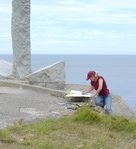|
A recent episode of the History Channel's "Battlefield
Detectives" program featured research on the D-Day battlefield
at Pointe du Hoc, France conducted by a team from Texas A&M
University's Center for Heritage Conservation. The feature aired
on March 4, 2006.
The Pointe du Hoc battle is of special interest to Texans, and
to Texas Aggies in particular, because it was there that, under
intense enemy fire, Col. James Earl Rudder, who would later become
president of Texas A&M, led the U.S. Army's Second Ranger
Battalion up the cliffs to knock out heavily fortified German
gun emplacements. This feat during the June 6, 1944 D-Day invasion
is widely considered one of the most heroic of World War II.
Texas A&M researchers spent the last two summers surveying
the Pointe du Hoc battlefield in order to create a comprehensive
site record that will serve as a reference for historians and
for future preservation and educational initiatives.
Last summer, a crew from "Battlefield Detectives" filmed
the Texas A&M team in the field at Pointe du Hoc. Richard
Burt, a construction science professor and member of the Center
for Heritage Conservation team, said the "Battlefield Detectives" episode
includes interviews with him and with fellow Texas A&M faculty,
including Robert Warden, an architecture professor, and Bruce
Dickson from the Department of Anthropology, as well as video
of Texas A&M College of Architecture students working at
the site.
The History Channel's promotion for the Pointe du Hoc segment
reads, "Dawn, June 6, 1944. The largest invasion in history
is under way. Four miles to the west of the Allied landings at
Omaha Beach, a flotilla of landing craft head towards Hitler's
'Atlantic Wall' defenses. They are carrying just 200 men of a
newly trained elite force - the United States Rangers. Their
objective is the vital German coastal defense gun battery on
a headland known as the Pointe du Hoc. Climbing the 90-foot cliffs
under a storm of German bullets and grenades, the Rangers find
that the German guns are not where they should be. What follows
is a desperate game of cat and mouse, as the Rangers attempt
to hunt down the guns. The story of their mission is remembered
now as one of the most extraordinary aspects of the D-Day landings."
More information about the Center for Heritage Conservation's
project at Pointe du Hoc is available online at
http://archone.tamu.edu/hril/projects/
pointe%20du%20hoc/HomePage.htm.
| |

Aggie at Pointe du Hoc monument site

A&M student surveys Pointe du Hoc

3D Visualization of monument site
Larger images>
|

